AYB200 Financial Accounting: Aerodrone Limited & Accounting Standards
VerifiedAdded on 2023/04/21
|7
|1454
|214
Report
AI Summary
This report evaluates the accounting transactions of Aerodrone Limited, focusing on its acquisition of a drone manufacturing business. It details journal entries related to the purchase, referencing specific paragraphs in Australian Accounting Standards (AASB), particularly AASB 3 concerning business combinations and the recognition of goodwill. The report also addresses depreciation, amortization, impairment, and inventory valuation, citing AASB 116, AASB 138, and AASB 136. Furthermore, it recommends a measurement basis, contrasting fair value and value-in-use, based on Conceptual Framework guidelines. The analysis covers legal costs, asset valuation, and the impact of technological advancements on recoverable amounts, providing a comprehensive overview of financial accounting principles in the context of Aerodrone Limited's business activities. Desklib provides students with access to a wealth of resources, including past papers and solved assignments, to aid in their studies.
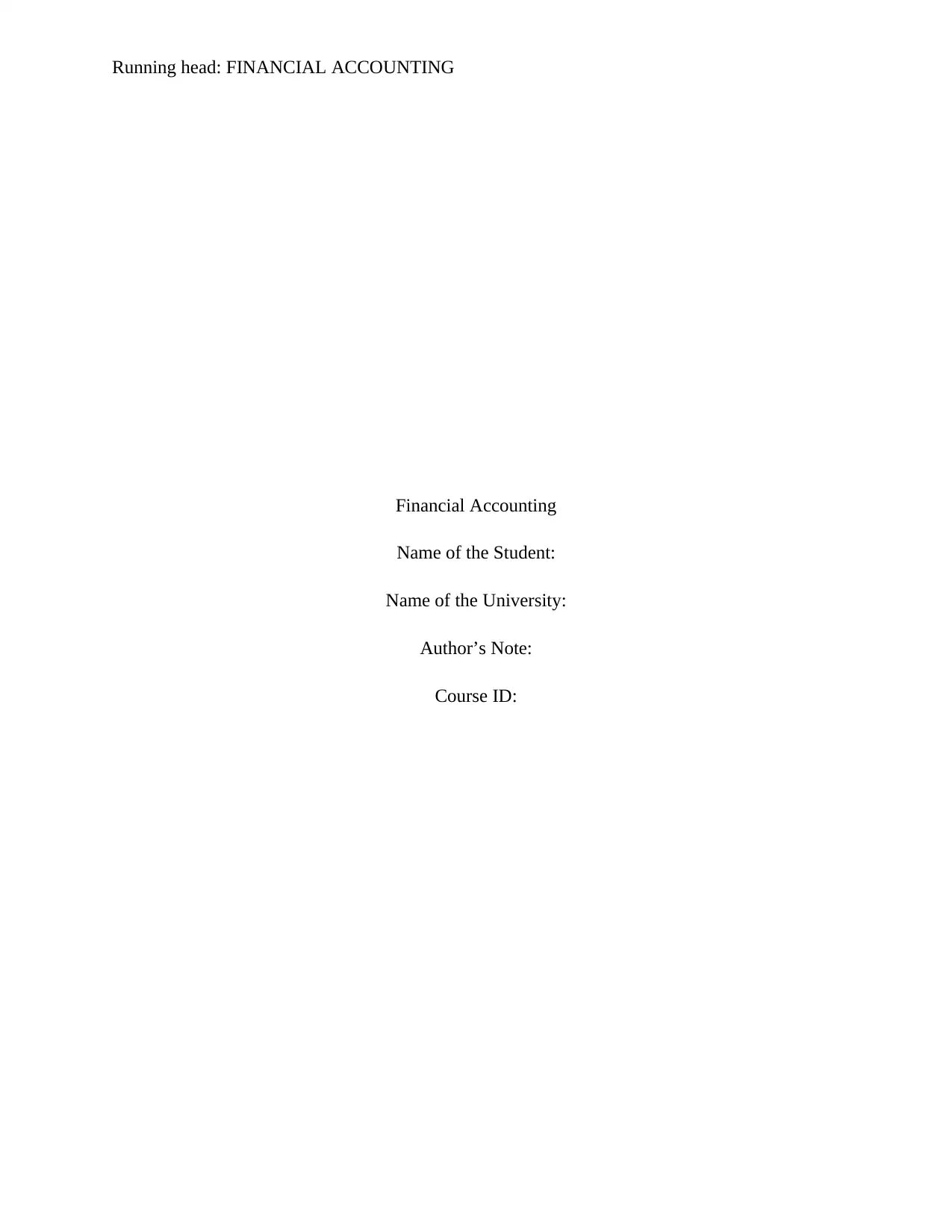
Running head: FINANCIAL ACCOUNTING
Financial Accounting
Name of the Student:
Name of the University:
Author’s Note:
Course ID:
Financial Accounting
Name of the Student:
Name of the University:
Author’s Note:
Course ID:
Paraphrase This Document
Need a fresh take? Get an instant paraphrase of this document with our AI Paraphraser
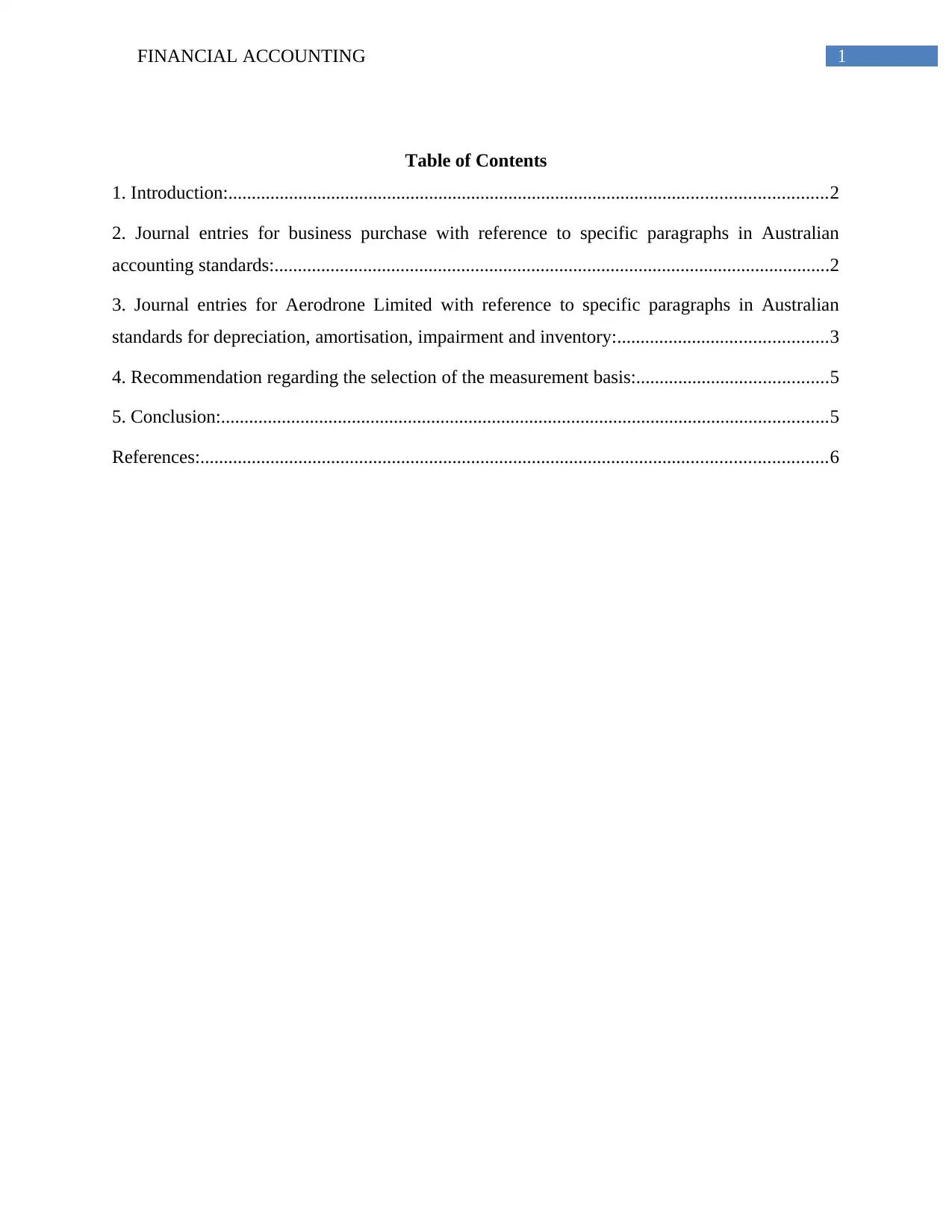
1FINANCIAL ACCOUNTING
Table of Contents
1. Introduction:................................................................................................................................2
2. Journal entries for business purchase with reference to specific paragraphs in Australian
accounting standards:.......................................................................................................................2
3. Journal entries for Aerodrone Limited with reference to specific paragraphs in Australian
standards for depreciation, amortisation, impairment and inventory:.............................................3
4. Recommendation regarding the selection of the measurement basis:.........................................5
5. Conclusion:..................................................................................................................................5
References:......................................................................................................................................6
Table of Contents
1. Introduction:................................................................................................................................2
2. Journal entries for business purchase with reference to specific paragraphs in Australian
accounting standards:.......................................................................................................................2
3. Journal entries for Aerodrone Limited with reference to specific paragraphs in Australian
standards for depreciation, amortisation, impairment and inventory:.............................................3
4. Recommendation regarding the selection of the measurement basis:.........................................5
5. Conclusion:..................................................................................................................................5
References:......................................................................................................................................6
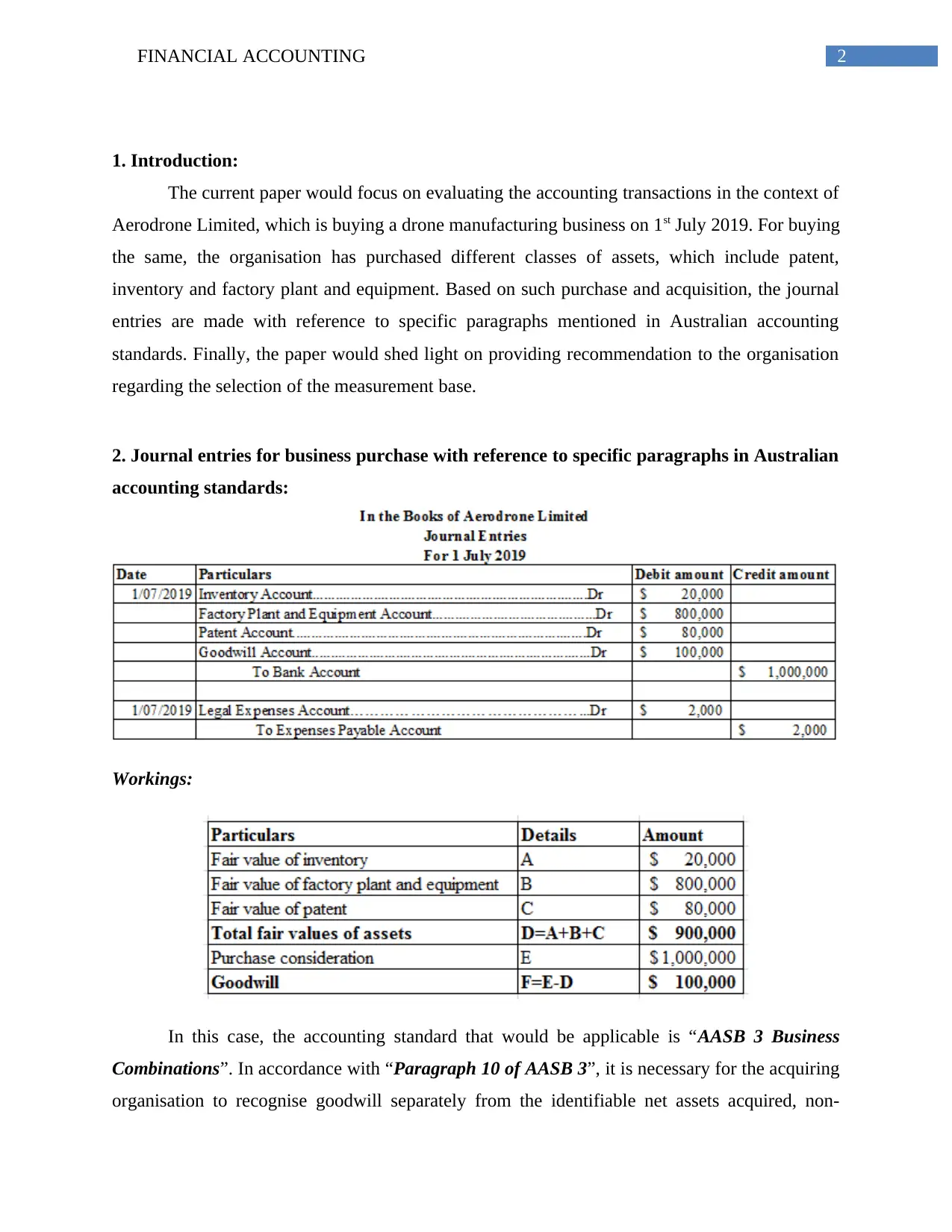
2FINANCIAL ACCOUNTING
1. Introduction:
The current paper would focus on evaluating the accounting transactions in the context of
Aerodrone Limited, which is buying a drone manufacturing business on 1st July 2019. For buying
the same, the organisation has purchased different classes of assets, which include patent,
inventory and factory plant and equipment. Based on such purchase and acquisition, the journal
entries are made with reference to specific paragraphs mentioned in Australian accounting
standards. Finally, the paper would shed light on providing recommendation to the organisation
regarding the selection of the measurement base.
2. Journal entries for business purchase with reference to specific paragraphs in Australian
accounting standards:
Workings:
In this case, the accounting standard that would be applicable is “AASB 3 Business
Combinations”. In accordance with “Paragraph 10 of AASB 3”, it is necessary for the acquiring
organisation to recognise goodwill separately from the identifiable net assets acquired, non-
1. Introduction:
The current paper would focus on evaluating the accounting transactions in the context of
Aerodrone Limited, which is buying a drone manufacturing business on 1st July 2019. For buying
the same, the organisation has purchased different classes of assets, which include patent,
inventory and factory plant and equipment. Based on such purchase and acquisition, the journal
entries are made with reference to specific paragraphs mentioned in Australian accounting
standards. Finally, the paper would shed light on providing recommendation to the organisation
regarding the selection of the measurement base.
2. Journal entries for business purchase with reference to specific paragraphs in Australian
accounting standards:
Workings:
In this case, the accounting standard that would be applicable is “AASB 3 Business
Combinations”. In accordance with “Paragraph 10 of AASB 3”, it is necessary for the acquiring
organisation to recognise goodwill separately from the identifiable net assets acquired, non-
⊘ This is a preview!⊘
Do you want full access?
Subscribe today to unlock all pages.

Trusted by 1+ million students worldwide
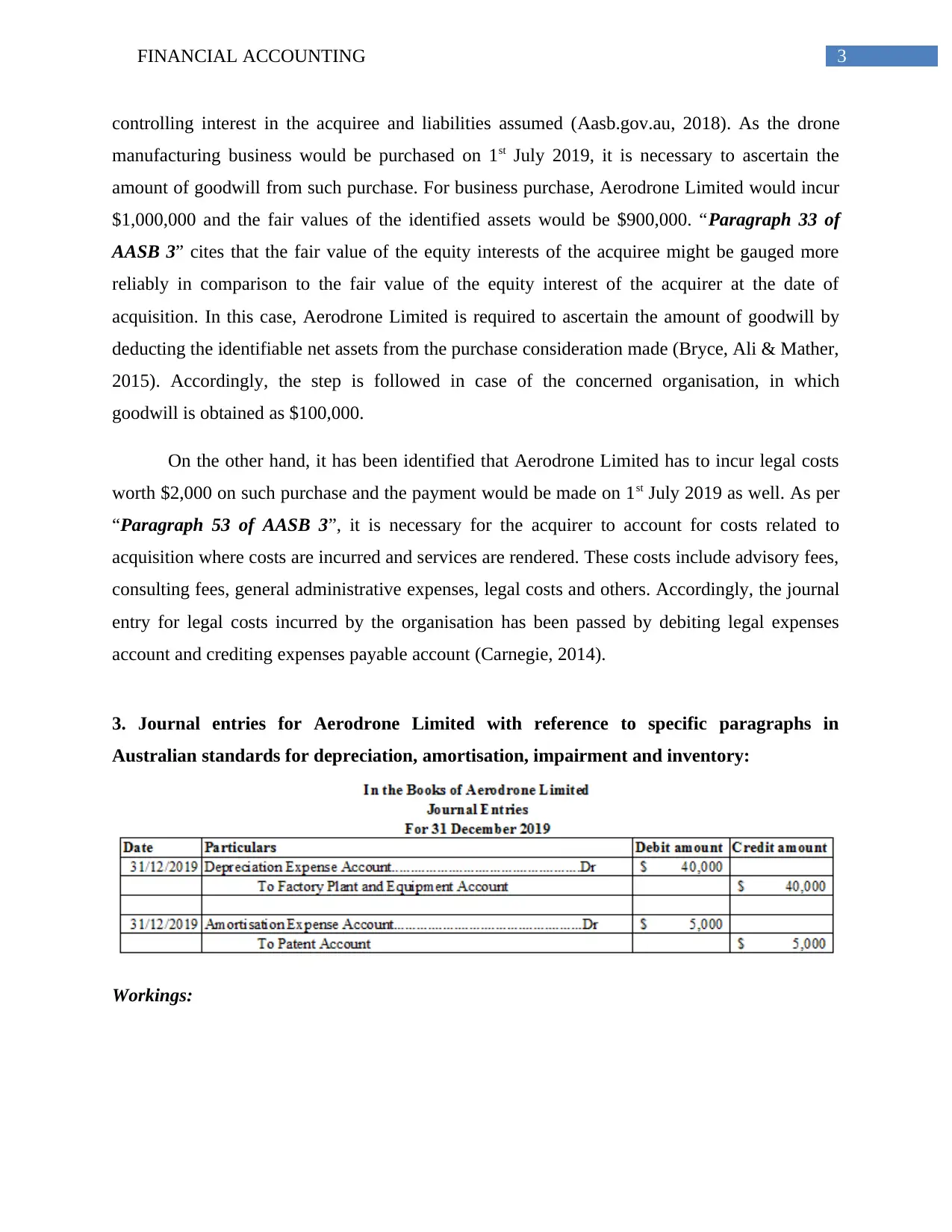
3FINANCIAL ACCOUNTING
controlling interest in the acquiree and liabilities assumed (Aasb.gov.au, 2018). As the drone
manufacturing business would be purchased on 1st July 2019, it is necessary to ascertain the
amount of goodwill from such purchase. For business purchase, Aerodrone Limited would incur
$1,000,000 and the fair values of the identified assets would be $900,000. “Paragraph 33 of
AASB 3” cites that the fair value of the equity interests of the acquiree might be gauged more
reliably in comparison to the fair value of the equity interest of the acquirer at the date of
acquisition. In this case, Aerodrone Limited is required to ascertain the amount of goodwill by
deducting the identifiable net assets from the purchase consideration made (Bryce, Ali & Mather,
2015). Accordingly, the step is followed in case of the concerned organisation, in which
goodwill is obtained as $100,000.
On the other hand, it has been identified that Aerodrone Limited has to incur legal costs
worth $2,000 on such purchase and the payment would be made on 1st July 2019 as well. As per
“Paragraph 53 of AASB 3”, it is necessary for the acquirer to account for costs related to
acquisition where costs are incurred and services are rendered. These costs include advisory fees,
consulting fees, general administrative expenses, legal costs and others. Accordingly, the journal
entry for legal costs incurred by the organisation has been passed by debiting legal expenses
account and crediting expenses payable account (Carnegie, 2014).
3. Journal entries for Aerodrone Limited with reference to specific paragraphs in
Australian standards for depreciation, amortisation, impairment and inventory:
Workings:
controlling interest in the acquiree and liabilities assumed (Aasb.gov.au, 2018). As the drone
manufacturing business would be purchased on 1st July 2019, it is necessary to ascertain the
amount of goodwill from such purchase. For business purchase, Aerodrone Limited would incur
$1,000,000 and the fair values of the identified assets would be $900,000. “Paragraph 33 of
AASB 3” cites that the fair value of the equity interests of the acquiree might be gauged more
reliably in comparison to the fair value of the equity interest of the acquirer at the date of
acquisition. In this case, Aerodrone Limited is required to ascertain the amount of goodwill by
deducting the identifiable net assets from the purchase consideration made (Bryce, Ali & Mather,
2015). Accordingly, the step is followed in case of the concerned organisation, in which
goodwill is obtained as $100,000.
On the other hand, it has been identified that Aerodrone Limited has to incur legal costs
worth $2,000 on such purchase and the payment would be made on 1st July 2019 as well. As per
“Paragraph 53 of AASB 3”, it is necessary for the acquirer to account for costs related to
acquisition where costs are incurred and services are rendered. These costs include advisory fees,
consulting fees, general administrative expenses, legal costs and others. Accordingly, the journal
entry for legal costs incurred by the organisation has been passed by debiting legal expenses
account and crediting expenses payable account (Carnegie, 2014).
3. Journal entries for Aerodrone Limited with reference to specific paragraphs in
Australian standards for depreciation, amortisation, impairment and inventory:
Workings:
Paraphrase This Document
Need a fresh take? Get an instant paraphrase of this document with our AI Paraphraser

4FINANCIAL ACCOUNTING
For recognising depreciation on factory plant and equipment, two types of model are
used, which include cost model and revaluation model. “Paragraph 30 of AASB 116” states that
in cost model, any item related to property, plant and equipment needs to be carried at cost after
deduction of impairment charges and accumulated depreciation. On the other hand, in
accordance with “Paragraph 31 of AASB 116”, any item related to property, plant and
equipment whose fair value could be gauged reliably needs to be carried at re-valued amount
after subtraction of accumulated depreciation and accumulated impairment losses (Aasb.gov.au,
2018). In this case, depreciation has been calculated using the cost model by taking into
consideration the useful life and half-yearly rate.
In order to recognise amortisation on patent, the models are same as cost model and
revaluation model, which are mentioned in AASB 138. As observed from “Paragraph 74 of
AASB 138”, any intangible asset needs to be carried at cost after accumulated amortisation and
accumulated impairment losses are subtracted from the concerned asset. In addition, “Paragraph
75 of AASB 138”, any intangible asset whose fair value could be gauged reliably needs to be
carried at re-valued amount after subtraction of accumulated amortisation and accumulated
impairment losses (Aasb.gov.au, 2018). The similar method, as in case of depreciation, is
followed for computing the amortisation on patent acquired by Aerodrone Limited.
After deduction of amortisation expense, the carrying amount of patent would be
obtained as $75,000 ($80,000 - $5,000). However, on 31st December 2019, the recoverable
amount of the patent would be $60,000. In this case, as per “AASB 136 Impairment of Assets”,
patent would be recorded at the recoverable amount, which is $60,000 (Aasb.gov.au, 2018).
For recognising depreciation on factory plant and equipment, two types of model are
used, which include cost model and revaluation model. “Paragraph 30 of AASB 116” states that
in cost model, any item related to property, plant and equipment needs to be carried at cost after
deduction of impairment charges and accumulated depreciation. On the other hand, in
accordance with “Paragraph 31 of AASB 116”, any item related to property, plant and
equipment whose fair value could be gauged reliably needs to be carried at re-valued amount
after subtraction of accumulated depreciation and accumulated impairment losses (Aasb.gov.au,
2018). In this case, depreciation has been calculated using the cost model by taking into
consideration the useful life and half-yearly rate.
In order to recognise amortisation on patent, the models are same as cost model and
revaluation model, which are mentioned in AASB 138. As observed from “Paragraph 74 of
AASB 138”, any intangible asset needs to be carried at cost after accumulated amortisation and
accumulated impairment losses are subtracted from the concerned asset. In addition, “Paragraph
75 of AASB 138”, any intangible asset whose fair value could be gauged reliably needs to be
carried at re-valued amount after subtraction of accumulated amortisation and accumulated
impairment losses (Aasb.gov.au, 2018). The similar method, as in case of depreciation, is
followed for computing the amortisation on patent acquired by Aerodrone Limited.
After deduction of amortisation expense, the carrying amount of patent would be
obtained as $75,000 ($80,000 - $5,000). However, on 31st December 2019, the recoverable
amount of the patent would be $60,000. In this case, as per “AASB 136 Impairment of Assets”,
patent would be recorded at the recoverable amount, which is $60,000 (Aasb.gov.au, 2018).

5FINANCIAL ACCOUNTING
However, as the inventory acquired has been damaged due to flood, it would be recorded at zero
owing to no retail value.
4. Recommendation regarding the selection of the measurement basis:
In accordance with “Paragraph 6.21 of the Conceptual Framework”, fair value is
considered as the selling price, which is agreed upon from the end of the buyer and the seller by
assuming that both parties are willing to enter into the transactions knowledgably and freely
(Aasb.gov.au, 2018). This method depicts the viewpoint of the market participants where asset or
liability is gauged using identical assumptions like those of the market participants. However, the
market participants need to act in the best interest of the economy.
On the other hand, “Paragraph 6.34 of the Conceptual Framework” states that value-in-
use is the net present value of cash flow or other benefits generated by an asset for particular use.
Thus, value-in-use is ascertained by using the measurement technique based on cash flows
(Henderson et al., 2015). For Aerodrone Limited, the recoverable amount has declined by
$500,000 owing to the development of new technologies in the drone industry, while the value-
in-use has been estimated to be much higher. Therefore, fair value needs to be used, as it has
lower value compared to value-in-use.
5. Conclusion:
From the above discussion, it has been evaluated that according to AASB 3, goodwill
needs to be identified distinctively from other assets during acquisition. Moreover, it is necessary
for the acquirer to account for costs related to acquisition where costs are incurred and services
are rendered. These costs include advisory fees, consulting fees, general administrative expenses,
legal costs and others. Finally, the research paper has provided critical overview of the various
accounting estimates related to depreciation, amortisation, impairment, fair value and value-in-
use.
However, as the inventory acquired has been damaged due to flood, it would be recorded at zero
owing to no retail value.
4. Recommendation regarding the selection of the measurement basis:
In accordance with “Paragraph 6.21 of the Conceptual Framework”, fair value is
considered as the selling price, which is agreed upon from the end of the buyer and the seller by
assuming that both parties are willing to enter into the transactions knowledgably and freely
(Aasb.gov.au, 2018). This method depicts the viewpoint of the market participants where asset or
liability is gauged using identical assumptions like those of the market participants. However, the
market participants need to act in the best interest of the economy.
On the other hand, “Paragraph 6.34 of the Conceptual Framework” states that value-in-
use is the net present value of cash flow or other benefits generated by an asset for particular use.
Thus, value-in-use is ascertained by using the measurement technique based on cash flows
(Henderson et al., 2015). For Aerodrone Limited, the recoverable amount has declined by
$500,000 owing to the development of new technologies in the drone industry, while the value-
in-use has been estimated to be much higher. Therefore, fair value needs to be used, as it has
lower value compared to value-in-use.
5. Conclusion:
From the above discussion, it has been evaluated that according to AASB 3, goodwill
needs to be identified distinctively from other assets during acquisition. Moreover, it is necessary
for the acquirer to account for costs related to acquisition where costs are incurred and services
are rendered. These costs include advisory fees, consulting fees, general administrative expenses,
legal costs and others. Finally, the research paper has provided critical overview of the various
accounting estimates related to depreciation, amortisation, impairment, fair value and value-in-
use.
⊘ This is a preview!⊘
Do you want full access?
Subscribe today to unlock all pages.

Trusted by 1+ million students worldwide
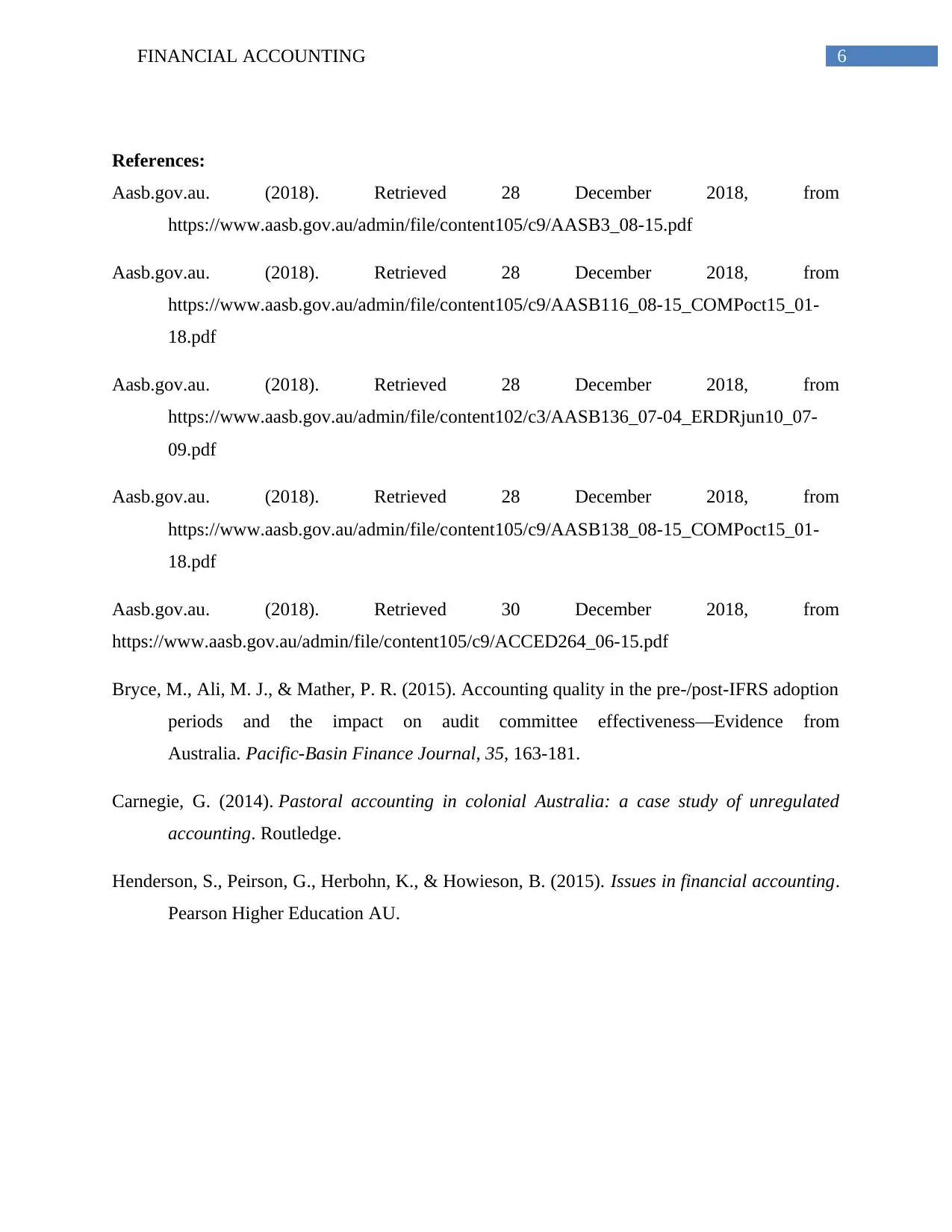
6FINANCIAL ACCOUNTING
References:
Aasb.gov.au. (2018). Retrieved 28 December 2018, from
https://www.aasb.gov.au/admin/file/content105/c9/AASB3_08-15.pdf
Aasb.gov.au. (2018). Retrieved 28 December 2018, from
https://www.aasb.gov.au/admin/file/content105/c9/AASB116_08-15_COMPoct15_01-
18.pdf
Aasb.gov.au. (2018). Retrieved 28 December 2018, from
https://www.aasb.gov.au/admin/file/content102/c3/AASB136_07-04_ERDRjun10_07-
09.pdf
Aasb.gov.au. (2018). Retrieved 28 December 2018, from
https://www.aasb.gov.au/admin/file/content105/c9/AASB138_08-15_COMPoct15_01-
18.pdf
Aasb.gov.au. (2018). Retrieved 30 December 2018, from
https://www.aasb.gov.au/admin/file/content105/c9/ACCED264_06-15.pdf
Bryce, M., Ali, M. J., & Mather, P. R. (2015). Accounting quality in the pre-/post-IFRS adoption
periods and the impact on audit committee effectiveness—Evidence from
Australia. Pacific-Basin Finance Journal, 35, 163-181.
Carnegie, G. (2014). Pastoral accounting in colonial Australia: a case study of unregulated
accounting. Routledge.
Henderson, S., Peirson, G., Herbohn, K., & Howieson, B. (2015). Issues in financial accounting.
Pearson Higher Education AU.
References:
Aasb.gov.au. (2018). Retrieved 28 December 2018, from
https://www.aasb.gov.au/admin/file/content105/c9/AASB3_08-15.pdf
Aasb.gov.au. (2018). Retrieved 28 December 2018, from
https://www.aasb.gov.au/admin/file/content105/c9/AASB116_08-15_COMPoct15_01-
18.pdf
Aasb.gov.au. (2018). Retrieved 28 December 2018, from
https://www.aasb.gov.au/admin/file/content102/c3/AASB136_07-04_ERDRjun10_07-
09.pdf
Aasb.gov.au. (2018). Retrieved 28 December 2018, from
https://www.aasb.gov.au/admin/file/content105/c9/AASB138_08-15_COMPoct15_01-
18.pdf
Aasb.gov.au. (2018). Retrieved 30 December 2018, from
https://www.aasb.gov.au/admin/file/content105/c9/ACCED264_06-15.pdf
Bryce, M., Ali, M. J., & Mather, P. R. (2015). Accounting quality in the pre-/post-IFRS adoption
periods and the impact on audit committee effectiveness—Evidence from
Australia. Pacific-Basin Finance Journal, 35, 163-181.
Carnegie, G. (2014). Pastoral accounting in colonial Australia: a case study of unregulated
accounting. Routledge.
Henderson, S., Peirson, G., Herbohn, K., & Howieson, B. (2015). Issues in financial accounting.
Pearson Higher Education AU.
1 out of 7
Related Documents
Your All-in-One AI-Powered Toolkit for Academic Success.
+13062052269
info@desklib.com
Available 24*7 on WhatsApp / Email
![[object Object]](/_next/static/media/star-bottom.7253800d.svg)
Unlock your academic potential
Copyright © 2020–2026 A2Z Services. All Rights Reserved. Developed and managed by ZUCOL.





